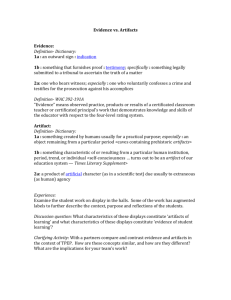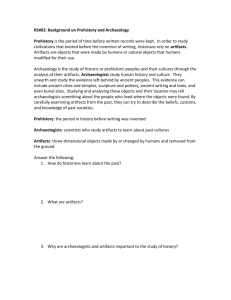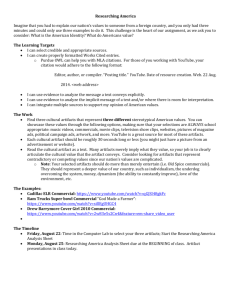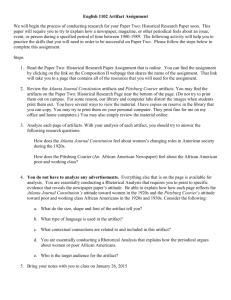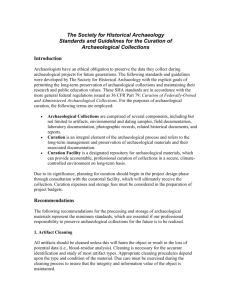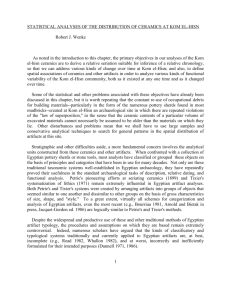Destruction/Preservation of artifacts
advertisement
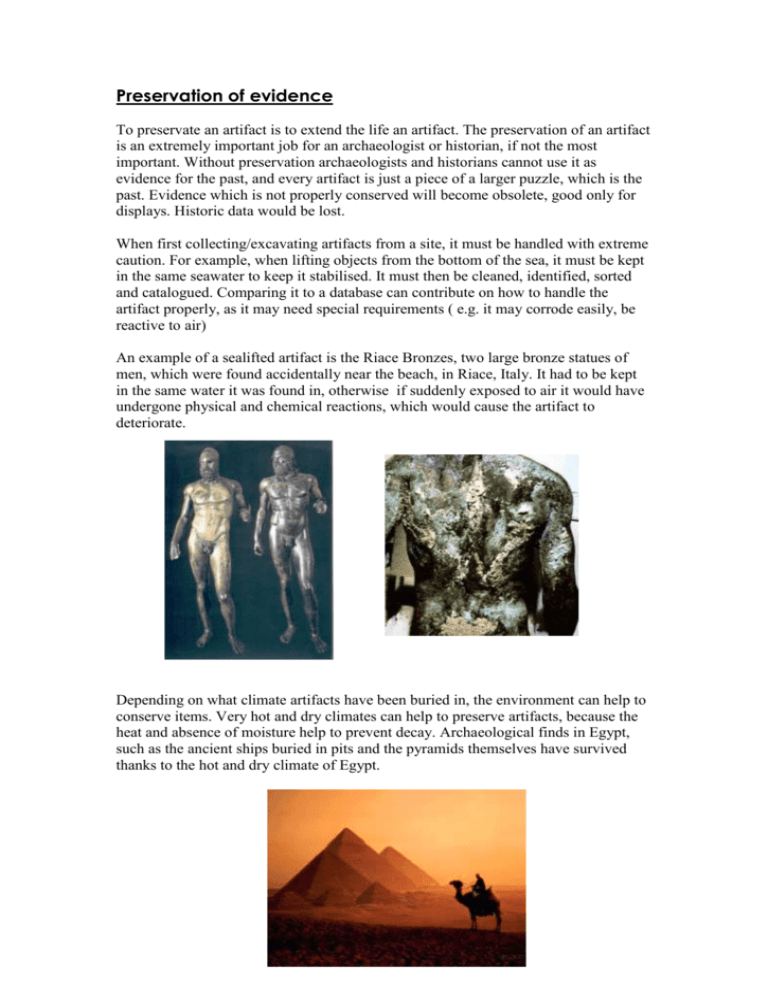
Preservation of evidence To preservate an artifact is to extend the life an artifact. The preservation of an artifact is an extremely important job for an archaeologist or historian, if not the most important. Without preservation archaeologists and historians cannot use it as evidence for the past, and every artifact is just a piece of a larger puzzle, which is the past. Evidence which is not properly conserved will become obsolete, good only for displays. Historic data would be lost. When first collecting/excavating artifacts from a site, it must be handled with extreme caution. For example, when lifting objects from the bottom of the sea, it must be kept in the same seawater to keep it stabilised. It must then be cleaned, identified, sorted and catalogued. Comparing it to a database can contribute on how to handle the artifact properly, as it may need special requirements ( e.g. it may corrode easily, be reactive to air) An example of a sealifted artifact is the Riace Bronzes, two large bronze statues of men, which were found accidentally near the beach, in Riace, Italy. It had to be kept in the same water it was found in, otherwise if suddenly exposed to air it would have undergone physical and chemical reactions, which would cause the artifact to deteriorate. Depending on what climate artifacts have been buried in, the environment can help to conserve items. Very hot and dry climates can help to preserve artifacts, because the heat and absence of moisture help to prevent decay. Archaeological finds in Egypt, such as the ancient ships buried in pits and the pyramids themselves have survived thanks to the hot and dry climate of Egypt. What the artifact is buried in also affects how it is preserved. For example, the presence of calcium can turn bones into hard stone. An example of an entire city preserved is the city of Pompeii, which were buried in layers of ash and mud when Mt. Vesuvius erupted. When preserving artifacts in a controlled environment, such as a museum, there are many factors which can affect their quality: Light: The best way to preserve an object is to keep it in the dark. Light damage is accumulated, and cannot be reversed. It can cause textiles to weaken and fade, paints to change colour or become darker, and paper can become weaker, a change in colour, or bleached/darkened. Temperature + Relative Humidity: An ideal temperature is from 20 – 22 degrees Celsius, and with a humidity level of around 45% to 55%. Fluctuation and sudden changes in temperature and humidity can cause damage, as materials are contracting and expanding. Air pollutants: Air pollutants, which include dirt, soot, pollens, ozone, nitrogen oxide and other chemicals can easily help to decay artifacts. A good filtering system can help prevent damage from this. Pests: Pests and small animals can cause quick damage to collections if let loose. Pests can include rodents, birds, beetles, termites, cockroaches and other animals. They can literally consume artifacts if they are of the right material. Destruction of Evidence There are many causes of decay, deterioration and the destruction of evidence. The most occurring reason for destruction of evidence is the natural environment. Natural processes of decay Damage from floods, earthquakes, volcanic eruptions, tsunamis and hurricanes, and erosion are some examples of natural processes which can damage historical evidence. Also, in the long term, the weathering effects of climate can also cause deterioration, such as heat, cold, rain and wind. Plants and animals also cause much damage to artifacts and evidence. Plants can crack, split and destroy architecture. Animal pests such as rodents, beetles, fungi and other bacteria can cause significant damage, from feeding on materials and droppings can affect materials. Examples of sites affected by natural processes are Kom Ombo, and the Cheops and Sakkarah pyramids. An earthquake occurred in 1992, and in Kom Ombo large blocks weighing 10 tonnes each had fallen because of the shock. The Cheops and Sakkarah pyramids each lost blocks, and some fissure damage. Damage also occurred to over 150 other Pharaonic, Coptic and Islamic monuments. Human causes of destruction The actions of people themselves have caused much damage to historical evidence. Warfare and conflict are the primary causes of destruction wreaked on evidence, meaning much historical data has been lost. People have mindlessly destroyed artifacts from the past, because of hate and disillusion. Barbarian tribes have destroyed other cultures and religions because of the love of conflict, or the hate for others. Mass tourism in the modern day is also a big culprit for destruction of evidence. Tourists walk around, photograph and touch archaeological sites. Multiplied by the 1000s that can visit an archaeological site in a single day, such as Abu Simbel, tourists can cause much damage. It is almost ironic because tourists come to visit sites, and yet destroy them while trying to appreciate them. Modern development is another threat to archaeological sites. Construction of residential and commercial areas, roads and tunnels, freeways, skyscrapers and other constructions destroy evidence beneath and around them. Traffic and industry also causes damage to evidence, because of the pollution they produce, which can seriously damage evidence. A particularly nasty form of pollution is acid rain, which acts like a corrosive agent. In Athens, the Acropolis and its temples, sculptures and other structures are being rapidly eaten away by this. Sources: Antiquity 1 Textbook http://wiki.spsu.edu/index.php/Preservation_of_Cultural_Artifacts http://www.loc.gov/preserv/careothr.html http://www.thc.state.tx.us/museums/musWord/BasicGuideforPreservHistArtifacts.doc http://archaeology.about.com/od/curation/Curation_and_Preservation_of_Artifacts.ht m http://nautarch.tamu.edu/class/anth605/File1.htm http://www.drgeorgepc.com/DisastersCulturalSites.html


